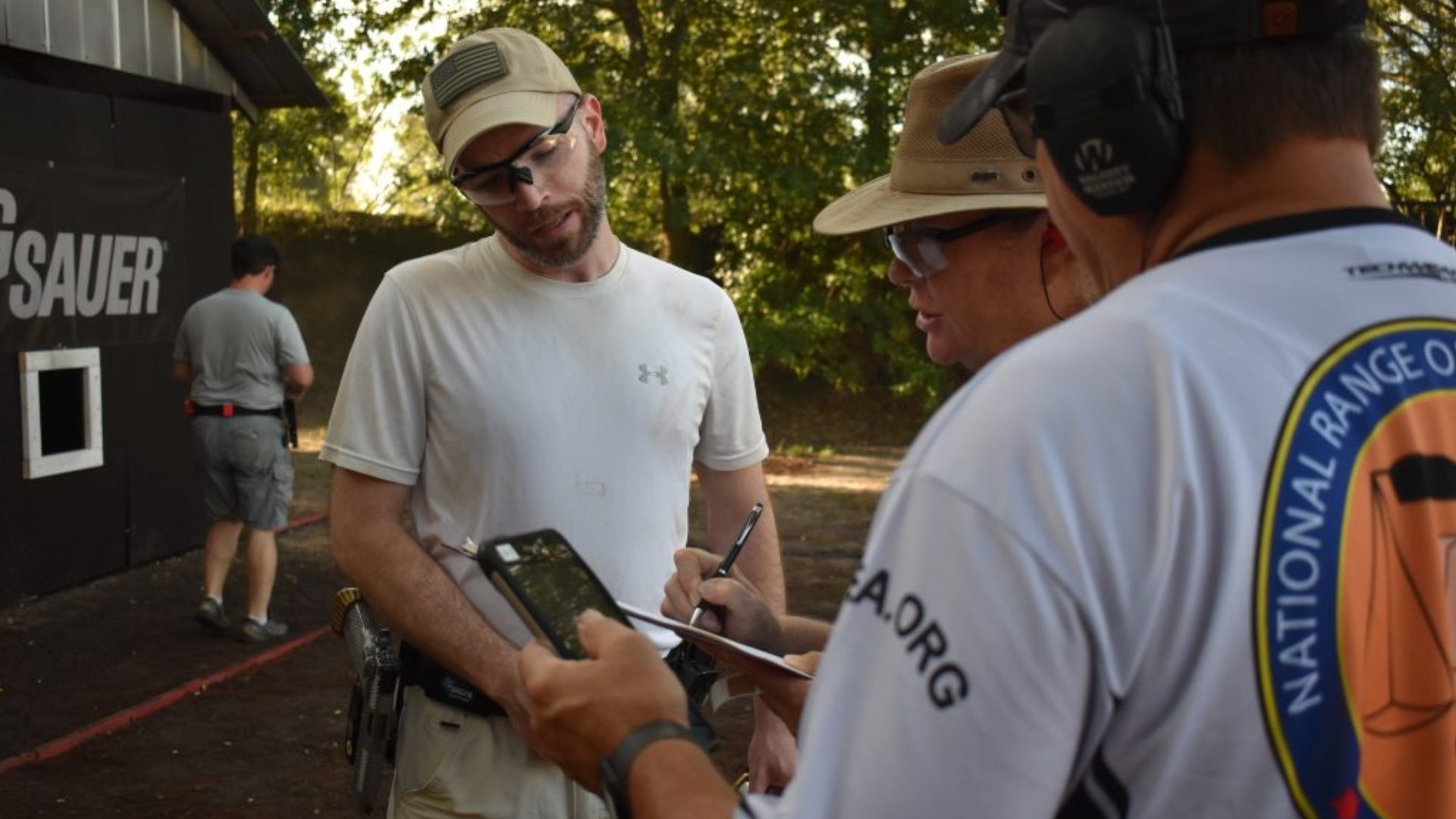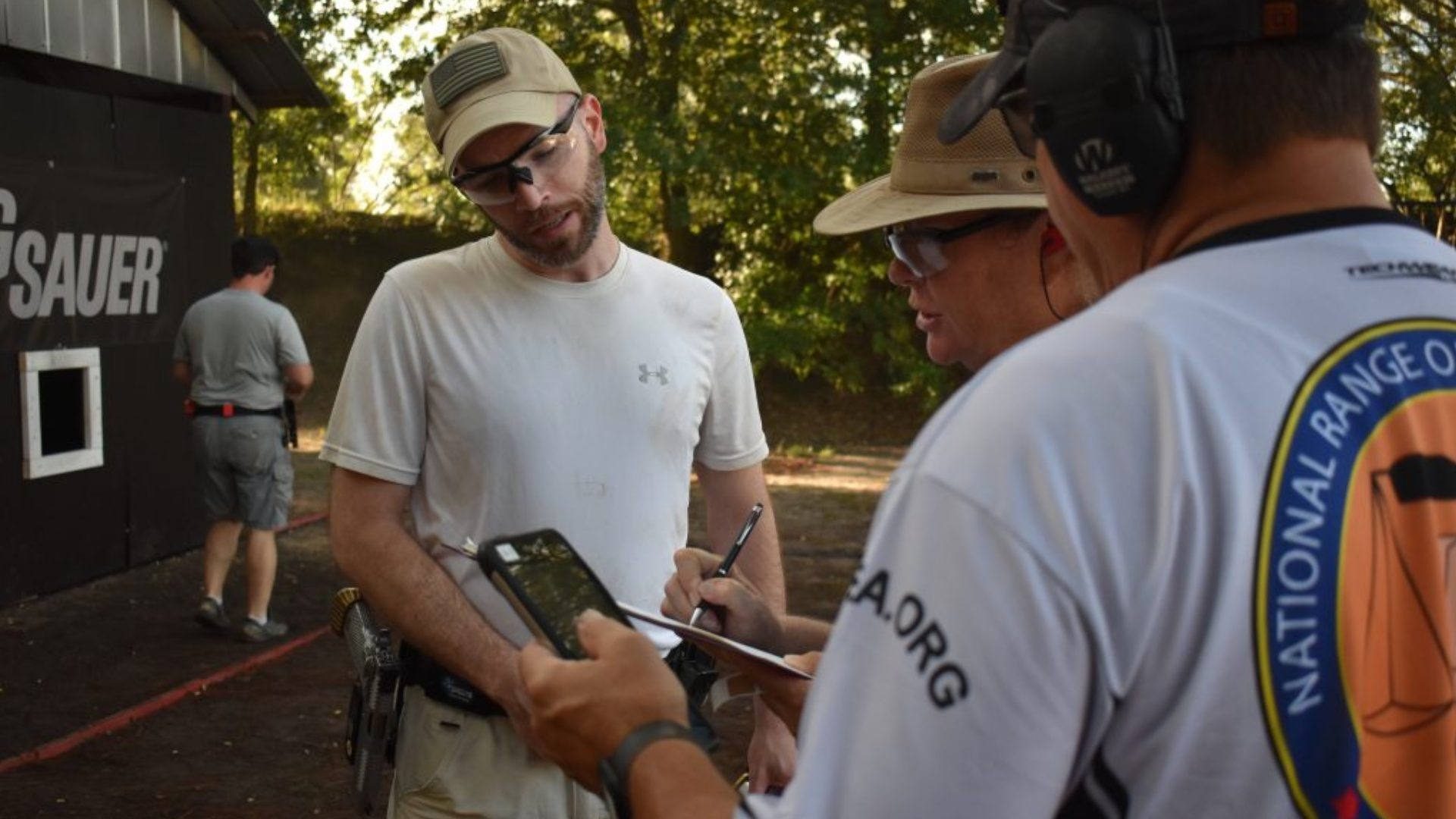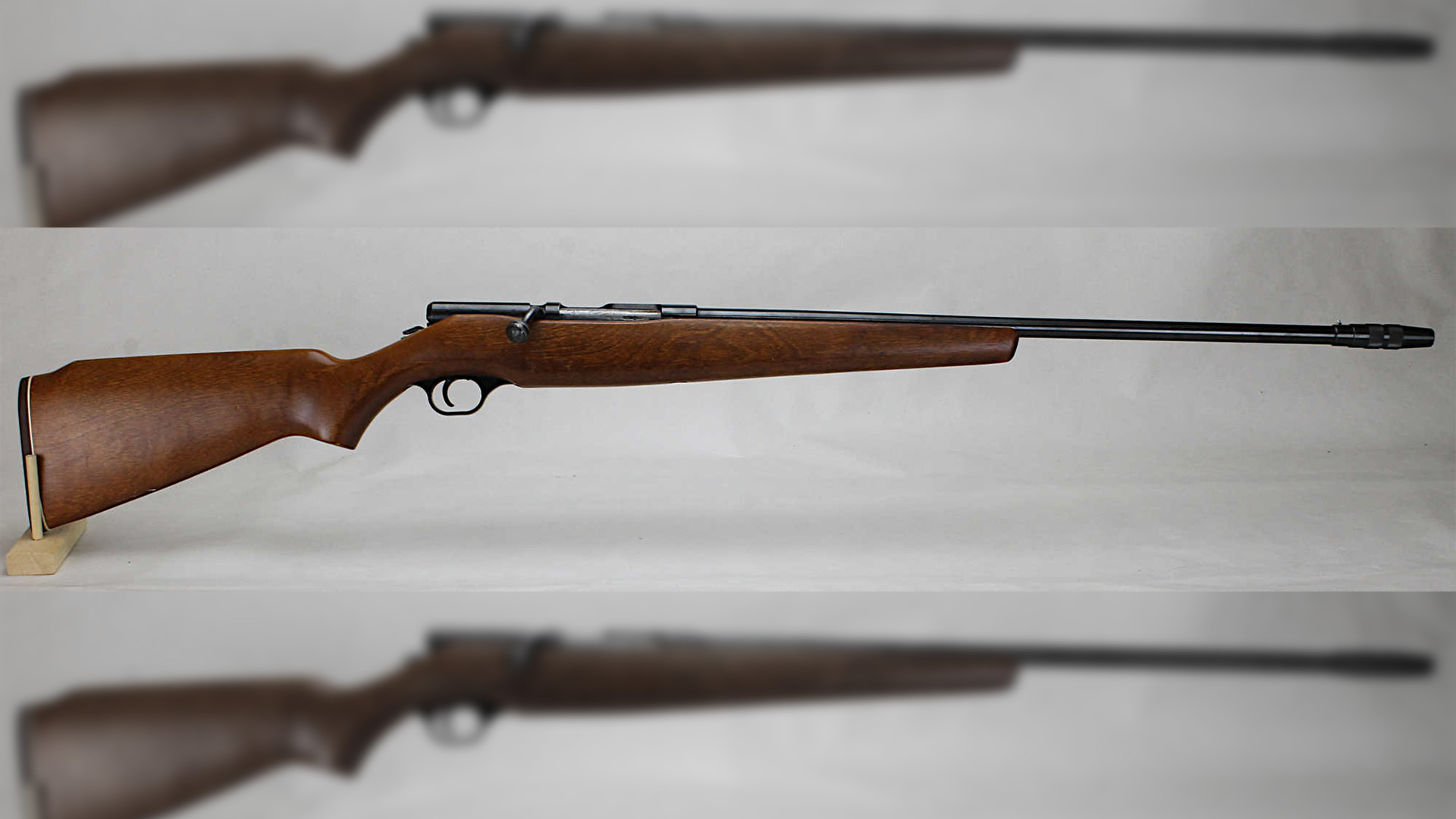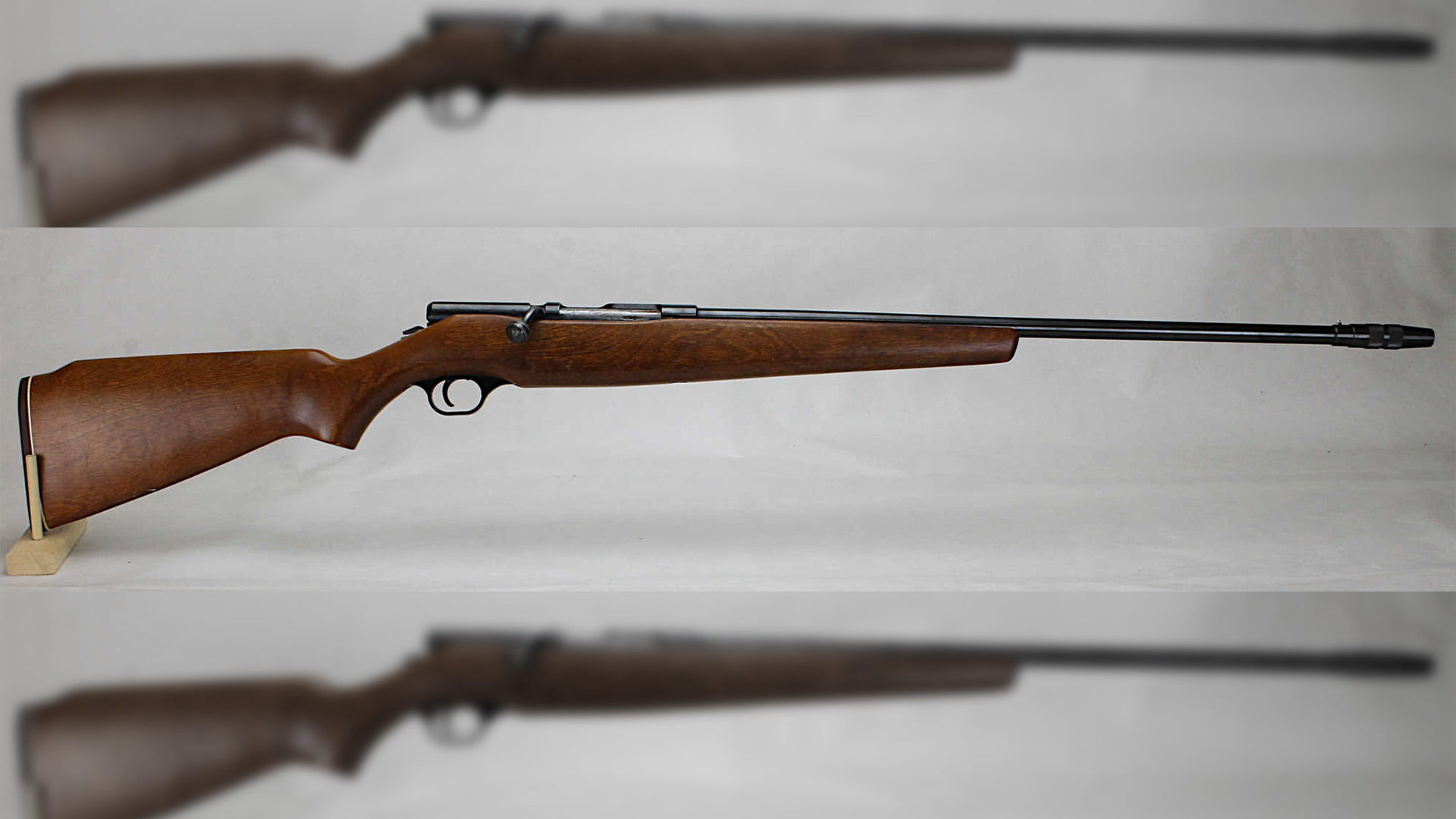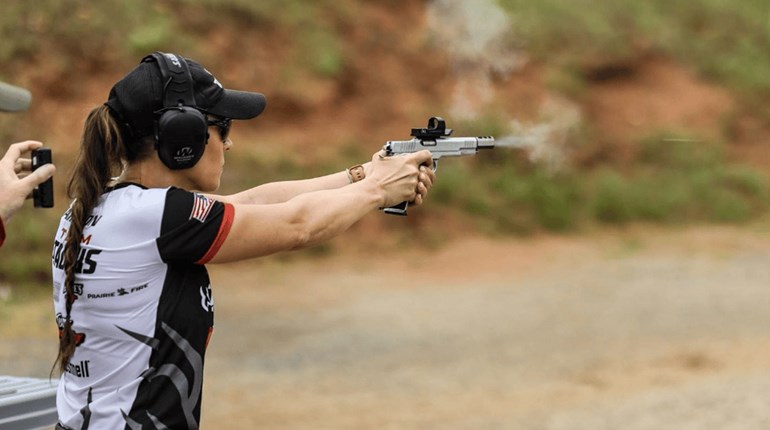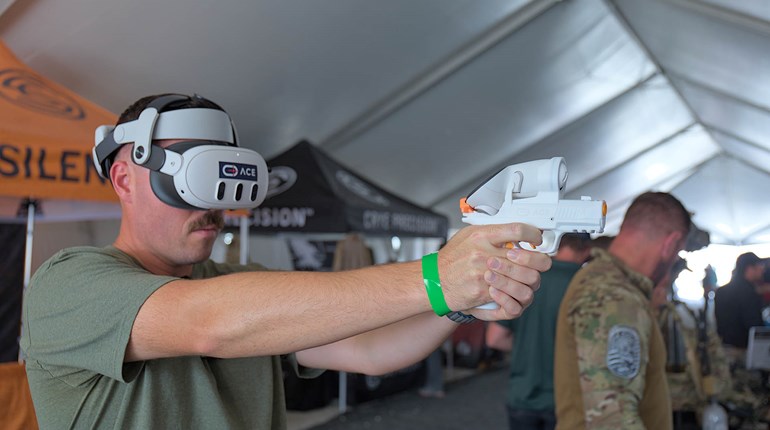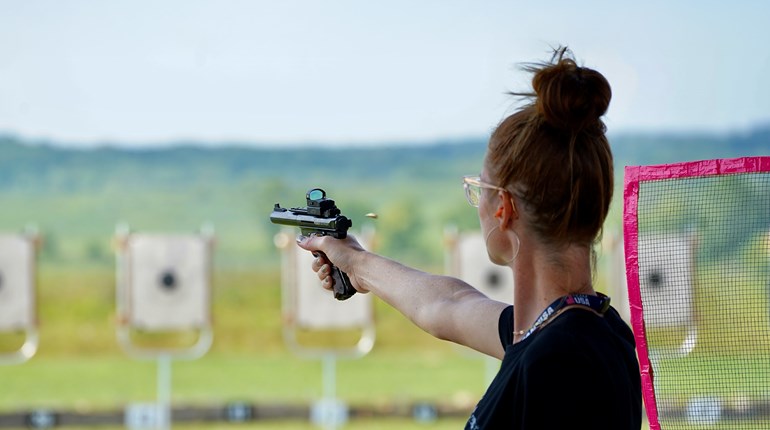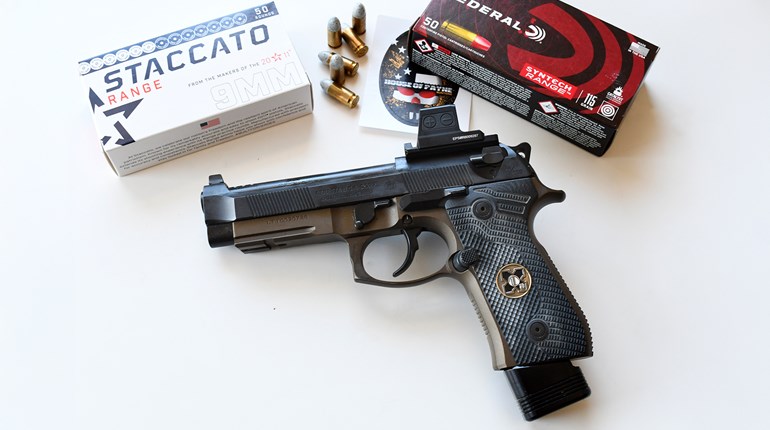
“Yes, but does it really work to produce results?” I have had several students ask me this question when I show videos to them from my Ace VR Virtual Shooting simulation training. When I tell them that the dot moves around more erratically for me in the game during recoil and movements, they almost never believe me. And yet here I am, training with a simulator six times a week and translating it into live-fire performance quicker than with traditional dry fire—enough so that I’ve used this training tool to improve my abilities that are producing perceptible live-fire results.
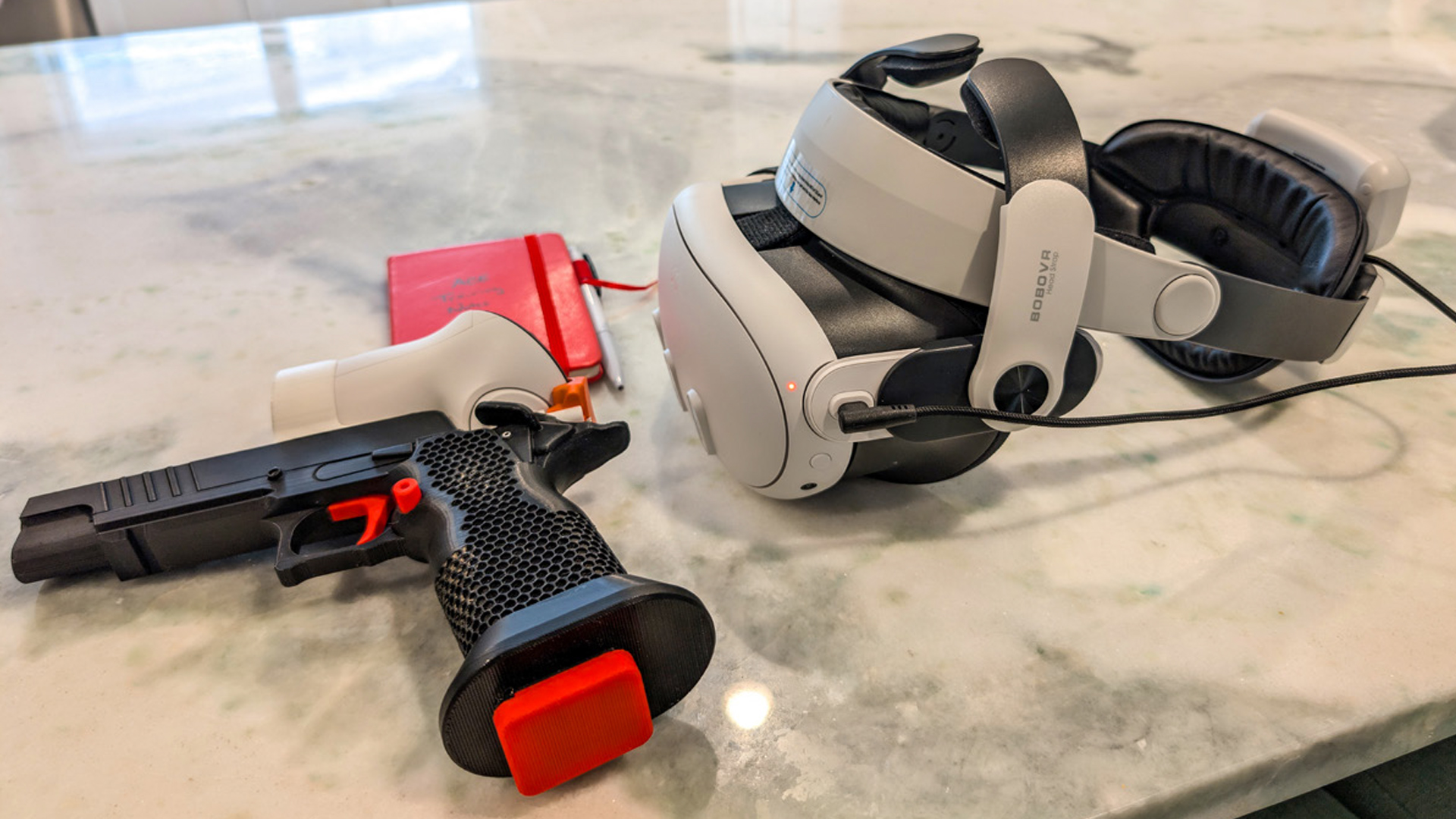
I stumbled upon this discovery with live-fire improvements when I didn’t have a chance to train live as much because of a busy schedule between work and classes. I was doing some lessons and classes and live firing once a week, compared to my three times a week that I spent most of the prior six months doing. I was teaching a law enforcement class for some law enforcement instructors, and I was demonstrating the metronome transition exercise. I observed that I was much more aware of what was going on (despite not practicing it in a while) and everything just felt slower, yet it was right on time with a high level of awareness and accuracy.
I raised the pace from 240 beats per minute (about 0.25 per split/transition) to 360 BPM (0.17 per split/transition) and repeated it. I always like to show the class where my current working level is so they understand the intention, which is to stretch the ability to process information without losing awareness of what is going on so we can correct it as we go. To my surprise, I had a better result here as well. I started to really believe that the training I was doing in VR was creating a positive change in my abilities at this point and decided to go all-in on an experiment that is still ongoing and having positive results. This article is about using this system to improve your shooting and performance all around with lessons I’ve learned from this experience.
SIMULATION TRAINING IN OTHER INDUSTRIES
There are other industries that use simulations to train the people within it. The idea is to be able to get the employees/ performers within that industry to improve their performance and experience for minimal cost and risk. For instance, flight simulators are used with pilots to expose them to different conditions to prepare them to succeed in the real world, where human life and the high cost of failure is a tremendous risk. The auto racing industry is another one that has highly evolved racing simulators that allow the driver to get a lot of repetition and the opportunity to push limits without wrecking a highly expensive race car. The realism of the tracks and the car dynamics allow for the drivers to test different approaches, lines on track and vehicle dynamics testing that they wouldn’t have quick access to otherwise without the use of a lot of resources (and money spent). This allows the driver to be trained in a more convenient and cost-effective way to get the most of results.
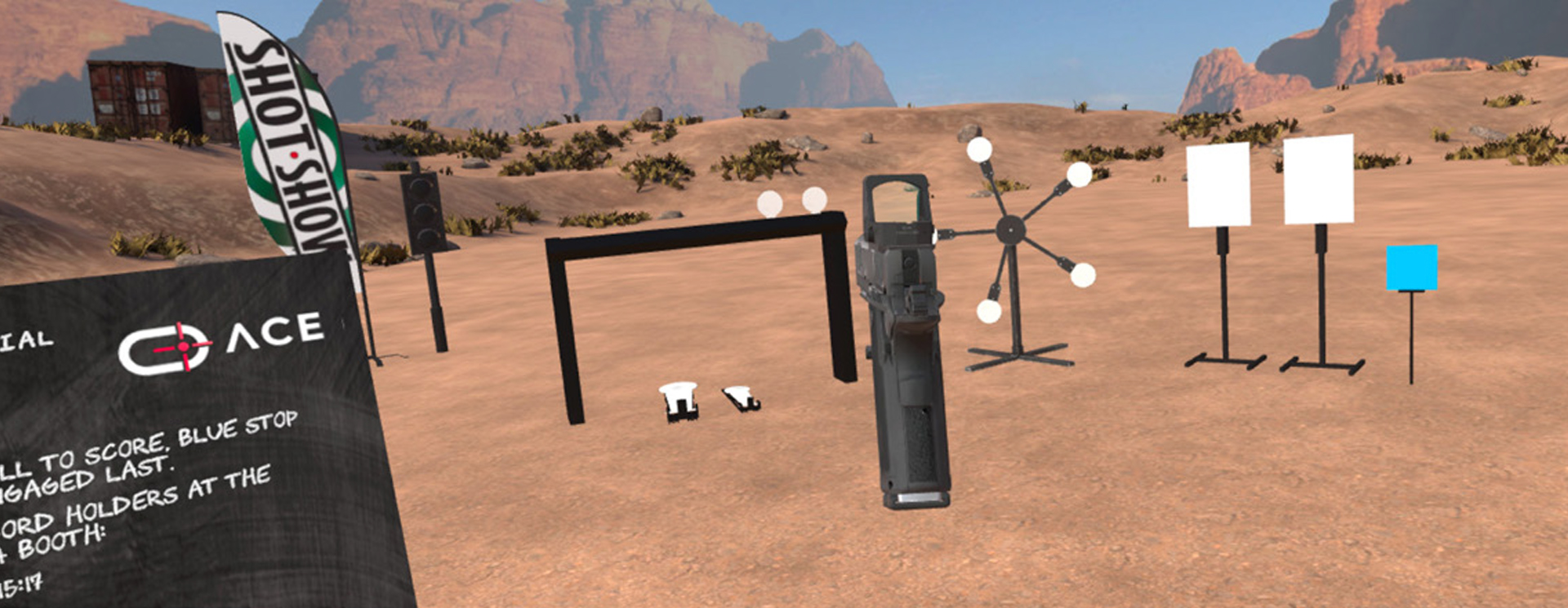
Within my own day job industry (Engineering and Plastic Injection Molding), there are injection molding simulators that can be used to test variables within the process to teach new molders how changes in this process affect part quality. We also use robotics, which some companies now have as full simulation tools to create entire work cells where you can program 98% of the robot from a computer and actually see what might happen before you even have the equipment set up in-house.
The point is that simulation tools are a tremendous benefit with minimal risk and cost associated with their use compared to the real-world cost and risk to “learning on the job.” Does it entirely substitute for actual real-world training? Not entirely, but I will get into that later. Can it get you appropriate training that can get you most of the way there? Absolutely!
HOW I LEARNED ABOUT ACE VR
Ace VR created the virtual training program I and many others are currently using to produce effective training that we’ve adapted to our current training regimens. I first started paying attention to this when I had heard Tim Herron discussing his use of it. Tim is an excellent instructor and high-level shooter in his own right, and not someone who will falsely inflate the effectiveness of a training tool, so I started to pay attention. Tim is a friend of mine, and we get along on a lot of levels (He’s even been on my Accelerator group calls twice now), so I trusted his opinion on this matter. I also liked how there were many different stages within the Ace VR program, and they were constantly adding more to it. I had a reasonable amount of space to train in that allowed for some movement so I figured I’d give it a try and see what I thought of it.
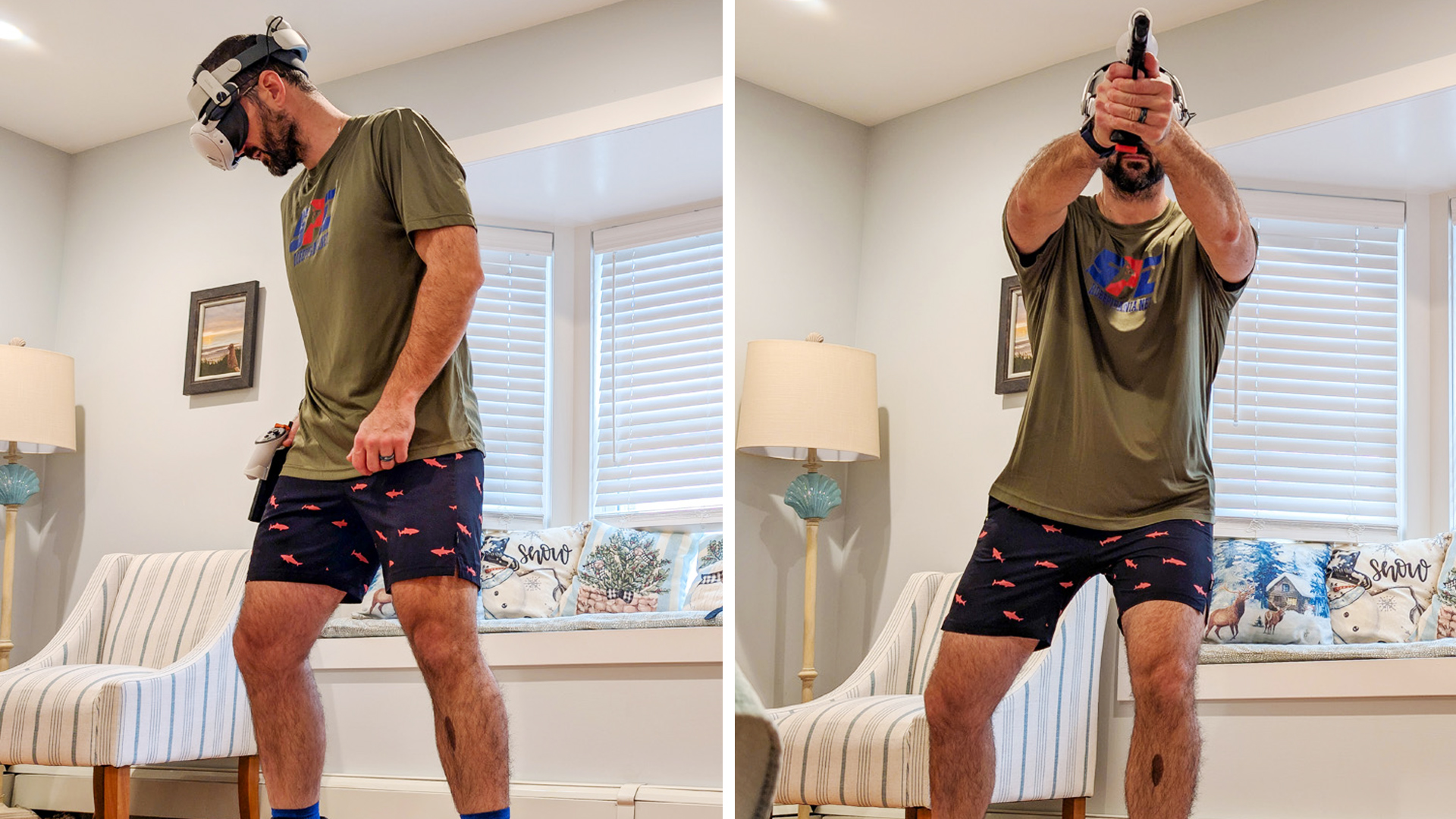
My dad generously bought me a Meta Quest 2 a few years back (I have recently upgraded to the Meta Quest 3), so for me the cost investment was reduced some to begin with, and in the spring of last year I bought into the program. A year membership and an Ace VR handset (modeled after the 2011s I shoot with a pretty similar feel) cost me around $450—the cost of two cases of ammo. Cleverly, Ace VR displays in your clubhouse the amount of rounds you have fired (in five-gallon buckets worth of brass), and the potential cost savings you have incurred as a result. To date, I’ve shot approximately 190,000 rounds in the game and, according to them, have saved $56,000. I took the time to really evaluate the system for its great points and its potential downfalls; I have found myself training more and more with it as a great supplement to live-fire training and dry fire as needed, and have found it tremendously valuable to this point.
WHAT I LIKE ABOUT TRAINING WITH ACE VR
There are many reasons I like training with this system. One of the biggest ones for me is that when I am in a game, I am fully immersed in training. In today’s world of distraction from social media and everything looking to get ahold of our most valuable asset—our attention—this allows me to be fully focused on the task at hand. Many people claim they dry fire for an hour daily, but do they really? It’s like when people say they work out for three hours—a lot of the time they are on their phone for five to 10 minutes between sets and they don’t realize it. That is not effective training by any metric, so being immersed in something without distraction is a huge opportunity to make progress.
Now, let’s say you’re able to remain focused for a session already—what are the other benefits to using this training tool? First off, it’s fun. The fact that it can feel like a game reminds me of a book I read by Adam Grant called “Hidden Potential” (excellent book, by the way). The concept expands on the concept of deliberate practice and is called “deliberate play.” The idea behind deliberate play is that you are working on the relevant skills that are important to success in your field and making them a fun challenge. By making it fun, you are more likely to continue in the practice for longer which, when combined with effective practice on the appropriate relevant skills to success, creates a much more effective learning environment.
In his book, Grant goes over several examples, of which the most notable one to me was from Steph Curry’s coach and the games they create for him to become the current record holder for most three-point shots made in the NBA. The point is, if you truly enjoy the process of learning and being challenged, and are working on the right skillsets to get you success, you’re much more likely to reach that goal. The stages are about as large or as small as your space allows, and it introduces a lot of relevant practice with setups that aren’t easily attained with dry-fire targets on the wall in a small room.
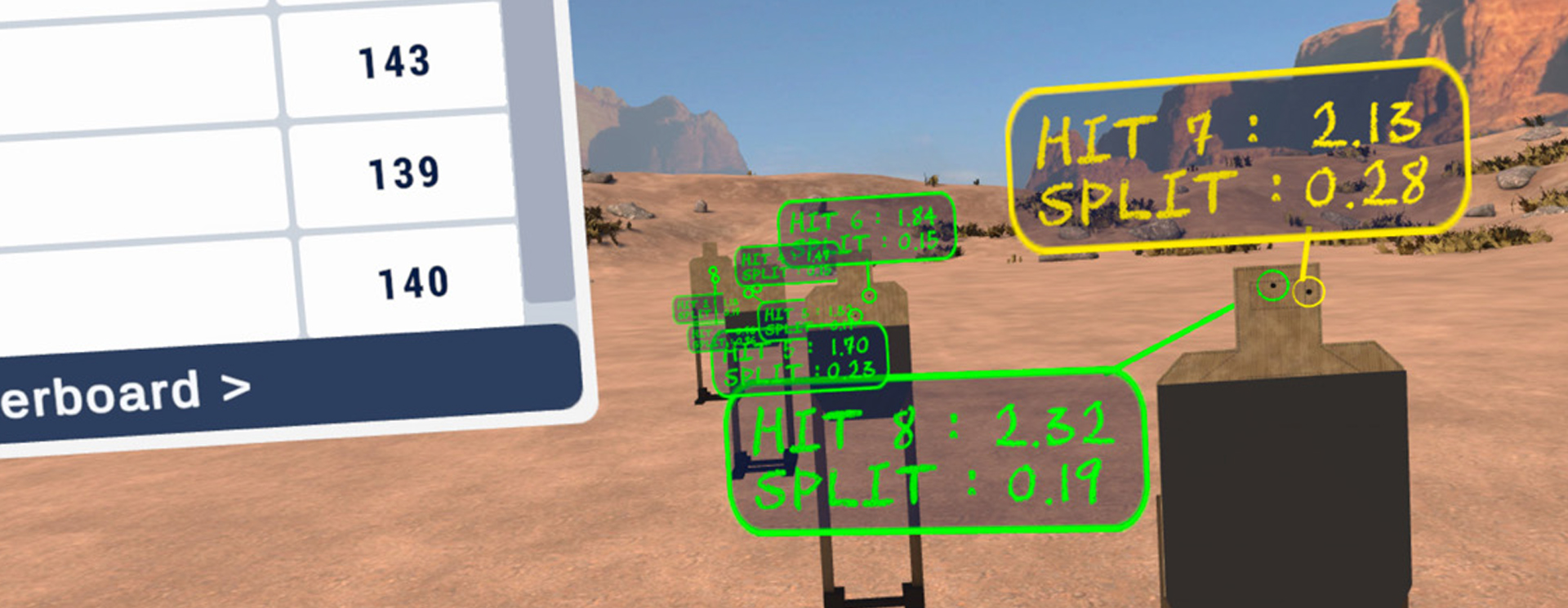
Secondly, it provides accountability to your training. Dry-fire practice is most effective when you have a high level of awareness of what is going on, as well as producing excellent results for those who can commit to it consistently. However, you are essentially making your best guess at where the dot or sights were on target when the trigger was pressed (or off of trigger lift, two of the three methods I teach in shot calling). Did you move the gun off target early, or did you hold on target too long? Training helps make this better, but it is still an estimate. Training tools can give you a higher level of accountability, too, but from the ones I’ve used in the past, they weren’t quite good enough for me to want to continue using them, versus using my own gun/sights/dot and having the ability to do multiple trigger presses.
Using the Ace VR system, I now have full accountability with what I thought I saw to what happened. You can get direct feedback on both your speed and accuracy after each run. In the game, after the run is completed, you get your time, your hits and your hit factor (just like a stage or live fire drill where you are paying attention to metrics). It even will give you information shot by shot (just like a shot timer) and which hits were which so that you can track specific metrics of data more accurately. Your estimated guesses are now immediately translated into short feedback loops to inform you if you were correct or not. Short feedback loops are key to gaining skills faster with better retention—it’s why I stress microdrills so much when breaking down certain skills.
Which brings me to the next point—not only do you have accountability for your training, but you also have a leaderboard to see what’s possible and get you thinking about how to get there. Using friendly competition to introduce a fun challenge can be a tremendous advantage to your skill growth. It allows you to focus on what you can do better to improve your scores, and you can pick specific actions to work on in a true deliberate play fashion. The exploration and experimentation aspect of training is critical to skill growth, and seeing that someone else can do better challenges you to figure out how you can do it better—true and effective training first hand. Find issues, create challenges, perform repetitions with an intentional focus and solve them to get to the next level of growth.
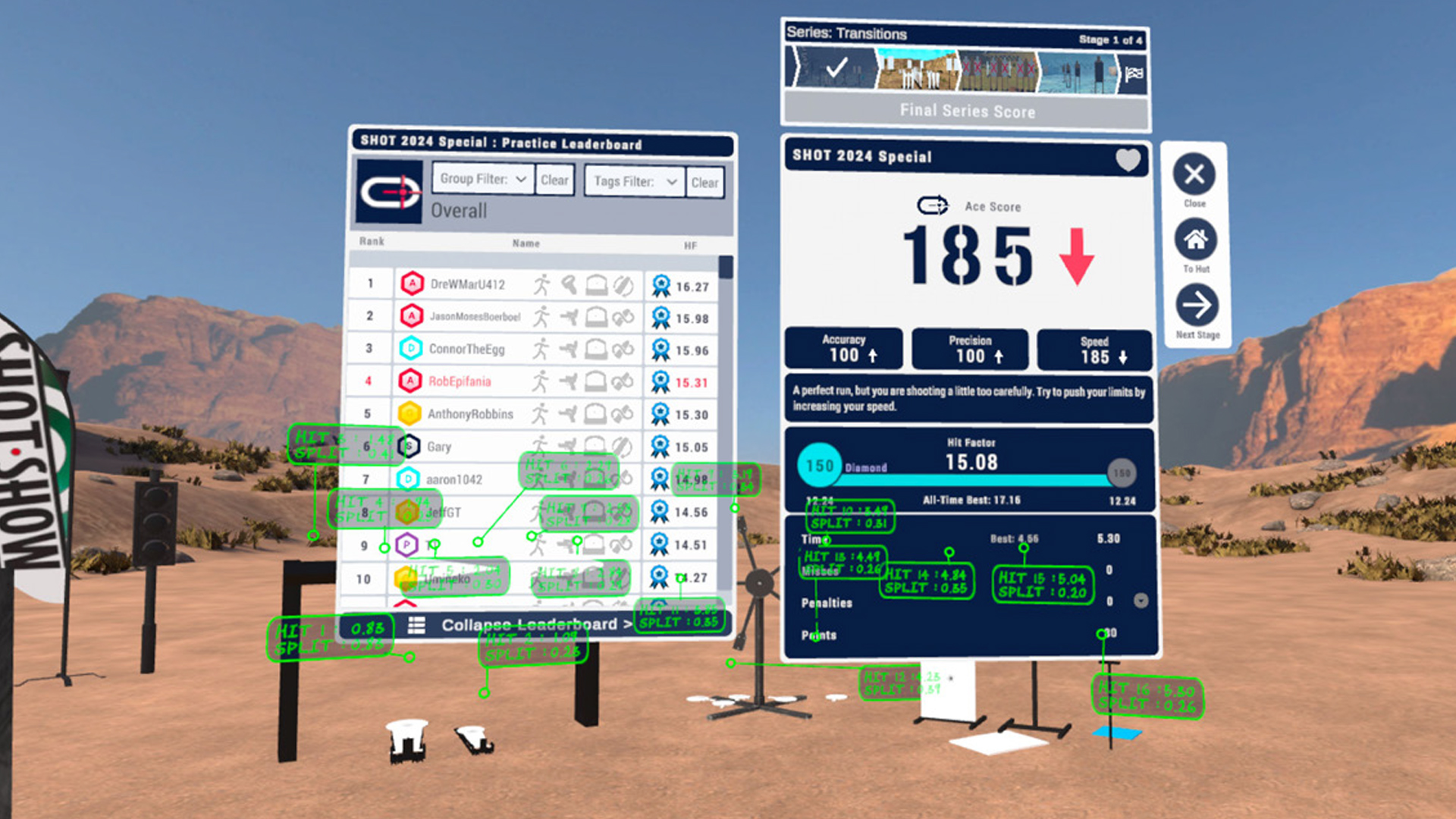
Lastly, as you improve your actual shooting fundamental skill, shooting and recoil become more visual. What are you seeing, and how quickly are you responding to it? If you think of practical shooting in its simplest form, the question to answer would always be: “How can I get to the next good shot sooner?” The Ace VR system highlights this fact. In the simulation, you have the traditional dot movement in visual recoil, transitions, gun handling and movement. You are learning how to develop a proper index that gets the dot/ sights on target sooner, which allows you to start shooting earlier. You are also processing this information through proper shot calling, which with visual recoil you can now use dot/sight lift (the most concrete method in my opinion) to more accurately call shots. Transition exits off of dot/sight lift are now possible just like in live fire, meaning you can more confidently exit a target and move assertively to the next one sooner off of what you see. As you start to challenge yourself by improving your scores, you start to stretch your level of vision and processing—which is a tremendous key to successful performance in live-fire competition. This is the awareness part I was discussing in the beginning of this article—I was able to see much more information at a higher rate of speed, making it feel almost boring in the process. I hadn’t been training live much at that point and only using Ace VR for dry fire—that is not coincidental. This is probably the largest benefit for higher level shooters in the simulation who are using the it as an effective training tool—your visual speed increases significantly.
From my perception, the dot in real life moves around less erratically and is easier to find for the first shot than in VR. So, by training to see this more erratic and harder to find dot in game, I’m actually translating it into real-world performance. I’ve talked with other high-level shooters like Tim and Sam Callahan as well, and they all agree on this as well, especially when used in the correct manner.
USING ACE VR EFFECTIVELY
There is a method to using this correctly, just as anyone would tell you when training with any potential training tool. I will document how I’m personally using it, but I know other high-level shooters are using it in a similar way but that might be slightly different. The key is to be able to deliver good live-fire and match performance, so that will be the outcome we desire.
When we shoot a match, we can only run the stages one time. Our intention is to deliver as close to our best potential performance in that one run. We have the opportunity to prepare with a proper walkthrough and make ready routine and can dry fire before at the safe table and during our make ready. With that said, proper training can generally take a similar approach. The most attention should be paid to the first repetition of any new exercise, as it represents what we are likely to do in a match. It can give valuable insights into where attention must be focused in order to achieve the results we would like in relation to our current ability level. After that initial first repetition, we can begin training to improve the areas that are the biggest opportunities for reaching the outcome we would like.
I use VR training in a similar way—the simulation has things called “series” exercises. They are four to five stages in a row (just like a match), where good performance depends on doing reasonably well in all of them. You don’t have to be number one on every stage on the leaderboard to be ranked No. 1 on the leaderboard, but you can’t bomb them, either. This is highly similar to a match.
When I start my training session, I begin with the series first. I have a notebook where I record my first and my best score on that series, to track metrics and progress. I give the first run in each series the level of attention and preparation I would normally give to a stage (this also helps you dial in what routine works well for you), and shoot it “as is”—no repeats, no do-overs. I record the first score and check it against previous first scores to see if I had a new best first run or if it was generally close to previous performances. If I had a new best, I will record it as a small win, which is highly important to developing your belief in your abilities. After that, I go into “training mode” on the series. My intention is to try to get the best possible score I can in the next few repetitions. This is not necessarily easy, because you can’t go all out on each stage as if you were just trying to “get lucky”—lucky works once, not four or five times in a row.
When I record what I feel is the best score I can get for that day, I compare my first score and my best score. The metric I’m using as a goal is that those scores are within five percent of each other, with a good general standard being between 5% and 10%. If it is above that, I would like to have worked very hard at making it happen! There is a subjective feel to that, and training like this, you will begin to know when that is occurring. I do this for several of these series in the game before moving to specific drills.
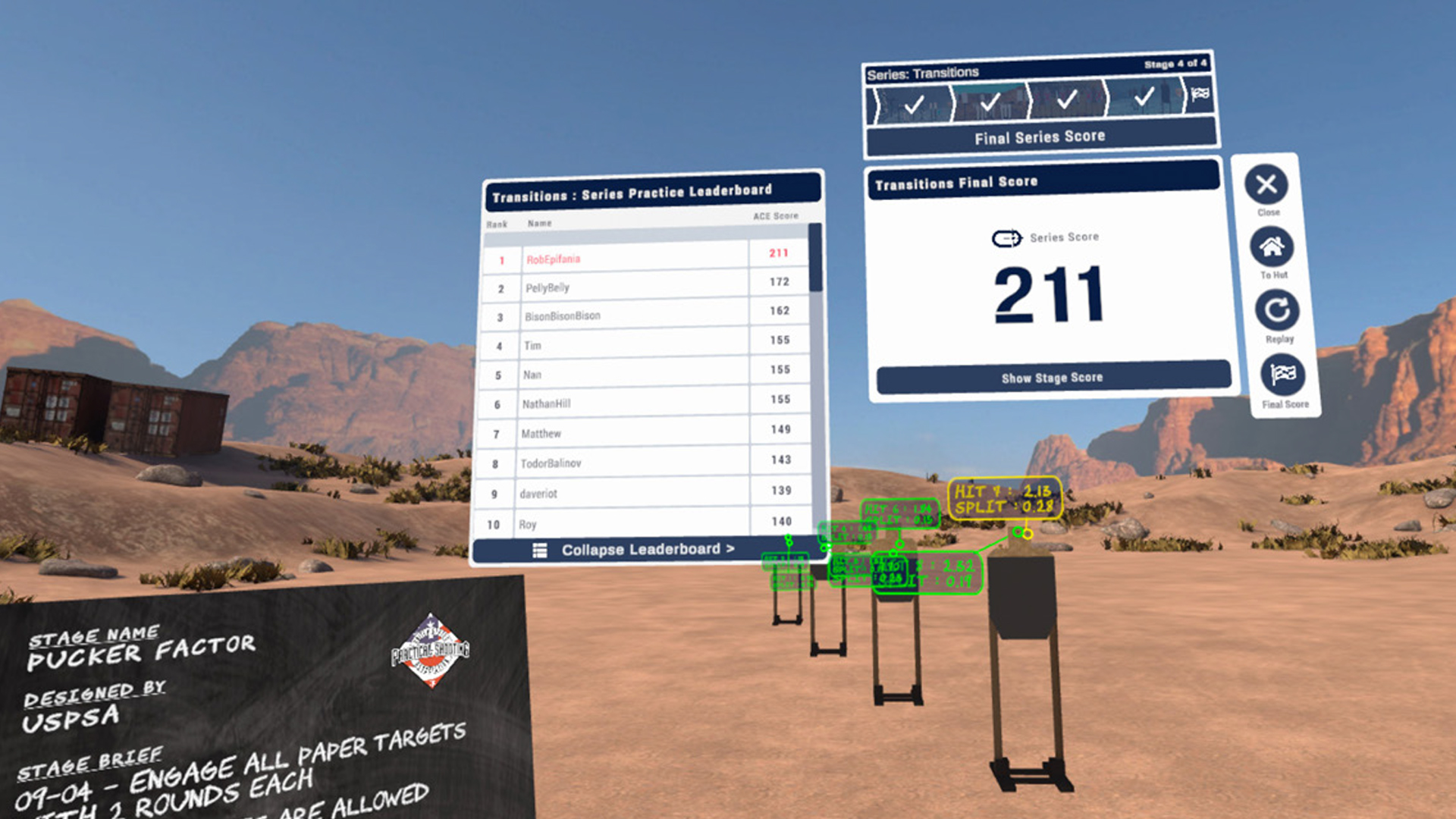
After this practice, I’ll move onto specific drills I’d like to use to improve my abilities. I personally like to focus a lot on shooting on the move and difficult transitions where you go from easy to hard targets the most at this point, so I’ll spend time there. The intention is similar where I look for a reasonable first run compared to my best runs, and then I will pick metrics to focus on to improve my scores. For instance, I might notice that a specific target transition needs attention, so I can create a standard that I will commit to (a 0.50 transition for instance) and work on solving the issues around that metric. This is highly focused skill development training, where I’m constantly stretching my comfort zone of what’s possible. I will also try different orders and add some randomized training in there so that I can see that scores are relatively similar with good performance in a variety of different ways.
In my notebook, I’ll record things that went well and choose one thing that I might like to do better for the next session. This continues the reflection process and works well with the metric tracking to ensure that the trend of scores continues upward. It also gives me the opportunity to remove how I might feel about something when objectively it is a good result. A lot of us can be harsh on ourselves even as we’re continuing to make progress, so having this check in place helps continue our growth appropriately.
Once a week, I will run each series only one time through and not allow myself any opportunity to run the drills within each series again. This is intended to heighten the pressure to deliver a good performance over 15 to 20 stages. This is true “one and done” training and is highly effective to improve your performance while making it feel much more like a match situation.
LOOK OUT FOR THIS WHEN YOU TRAIN WITH ACE VR
Something to be aware of when you’re using this game is that it can be easy and tempting to just try to chase a high score for the sake of getting lucky one time. This is akin to the Instagram runs you hear people speak of (and all of us have been guilty of at one point or another, myself included). I call these “junk reps” and they are not helping you—they are likely even doing harm to your abilities. Junk reps are when you no longer are paying attention or aware of what’s going on and are just “sending it” to get lucky. You can notice this is happening because you’re just putting tremendous amounts of effort into moving as fast as possible, but not really seeing anything good. Doing it this way, you will get lucky probably one time, but you are doing 25 or 50 reps to get that one time. Pay close attention to when you feel yourself start to spiral that way and pull out of it, because it will not be effective training, and it can potentially create bad habits. The goal is to stretch the ability when exploring while being fully aware of what’s happening. It doesn’t have to be perfect to be effective, but you do have to have the awareness to see what’s going on in order to address it.
WHAT VR TRAINING WITH ACE DOESN’T DO
So, this is a great training tool to enhance your practice if used right. The question becomes, what doesn’t it do? For one, it doesn’t replace handling your firearm entirely. You can get close with some of the handsets Ace VR has and some of the aftermarket 3D printed ones (shout out to @71_creative for mine.), but I’d highly recommend making sure to take some time handling your actual firearm to make sure that the skills you’re practicing in the game are translating to your actual gun.
Some people draw in the game as well, but I personally don’t. I present from the chest, as that’s the second part of the draw and I don’t have to put on my belt and everything else to get started. The reloads are not realistic enough to really be effective practice either. I’d highly recommend that people separate this part of practice from the game, as it won’t really provide a lot of value compared to traditional dry-fire practice. Plan to spend five to 10 minutes separate from the game to work on things like draws and reloads to effectively work on them (my website has a lot of info about these).
It does not replace proper live-fire training either. I think it can reduce the volume of live fire needed in times where live fire isn’t as critical (winter months, etc.), but live fire to a consistent degree is still necessary to make sure what you’re doing in-game is translating over into it. The higher your level of skill, the more the visual recoil in-game will be, as I described (more erratic than actual shooting). If your fundamental shooting ability needs attention, make sure you are working on this as a complement to your training in-game. The lower your shooting fundamental skill, the more the inverse of what I said is true (the dot in game will move less than in live fire).
It is not 100% perfect and is subject to some of the typical issues that might happen in a game. For instance, on moving targets I notice the hits skew away from where the target is moving for some reason. That is not the end of the world, as I’m aware of it and can call shots appropriately, but it is noticeable. Additionally, I have to delay my exit from one target to the next slightly to avoid any lag of registering the shot properly. It’s minimal but it is there. That doesn’t outweigh the positives I’ve seen, and it shouldn’t be something to discourage purchase or use, but it is something you must know.
WHICH META QUEST SHOULD I BUY IF I DON’T HAVE ONE
It should be mentioned that if you don’t have a Meta Quest headset just yet, there are basically two current options. The Quest 3S is less expensive but has lower resolution and lenses that have less of a “sweet spot.” The Quest 3 is the opposite of that—higher initial price, better resolution and better lenses. What this basically means is that the further targets in game appear much clearer in the Meta Quest 3 versus the 3S. My Meta Quest 2 was similar in this fashion, and I’d notice that when in a lean or looking at further targets that it would appear much blurrier. What I personally tell people (and I’ve done myself ) is this—you should get what you can afford if the option is Quest 3S or nothing; however, if both options are within your budget and you want the best potential training return for the investment, get the Meta Quest 3. The resolution upgrade and lens quality is noticeable—I’m glad I personally upgraded
FINAL THOUGHTS
I think when used appropriately with the right focus, VR-style training with the Ace VR system is a significant benefit added to a competition shooter’s training toolbox. It can allow you to gain accountability and have healthy comparisons that deliver thought-provoking progress in your skillset. For the cost of several cases of ammunition, you can gain tremendous visual and processing abilities that will translate over into your actual live-fire shooting—returning that cost of investment with compound interest toward your performance. The future is now, and that future is with virtual reality training with Ace VR.
Article from the March/April 2025 issue of USPSA’s magazine.









